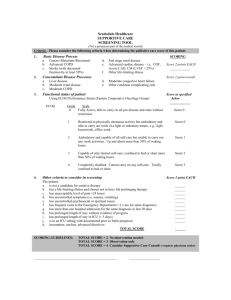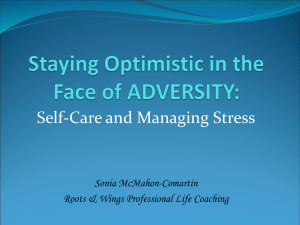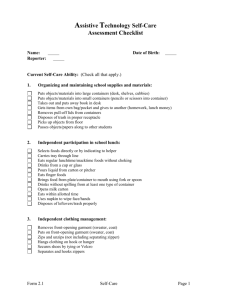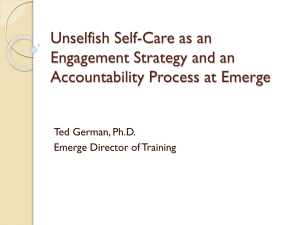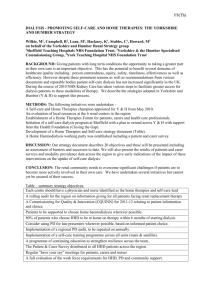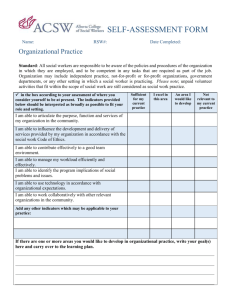Stress Theory, Health, and Health Care
advertisement
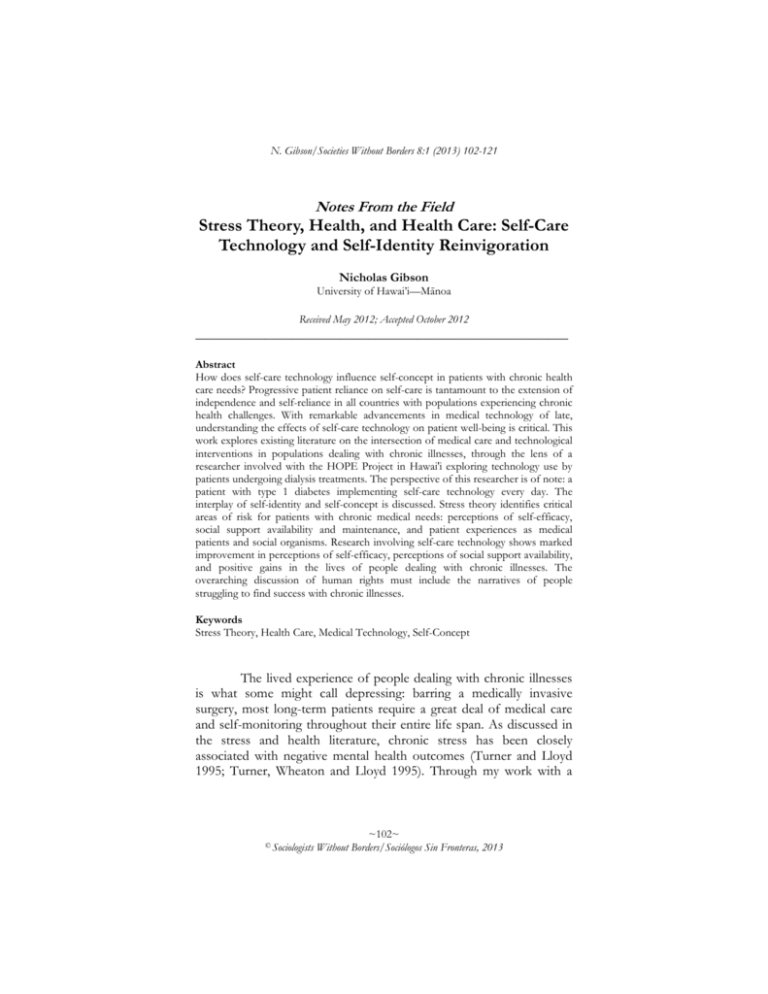
N. Gibson/Societies Without Borders 8:1 (2013) 102-121 Notes From the Field Stress Theory, Health, and Health Care: Self-Care Technology and Self-Identity Reinvigoration Nicholas Gibson University of Hawai’i—Mānoa Received May 2012; Accepted October 2012 ______________________________________________________ Abstract How does self-care technology influence self-concept in patients with chronic health care needs? Progressive patient reliance on self-care is tantamount to the extension of independence and self-reliance in all countries with populations experiencing chronic health challenges. With remarkable advancements in medical technology of late, understanding the effects of self-care technology on patient well-being is critical. This work explores existing literature on the intersection of medical care and technological interventions in populations dealing with chronic illnesses, through the lens of a researcher involved with the HOPE Project in Hawai'i exploring technology use by patients undergoing dialysis treatments. The perspective of this researcher is of note: a patient with type 1 diabetes implementing self-care technology every day. The interplay of self-identity and self-concept is discussed. Stress theory identifies critical areas of risk for patients with chronic medical needs: perceptions of self-efficacy, social support availability and maintenance, and patient experiences as medical patients and social organisms. Research involving self-care technology shows marked improvement in perceptions of self-efficacy, perceptions of social support availability, and positive gains in the lives of people dealing with chronic illnesses. The overarching discussion of human rights must include the narratives of people struggling to find success with chronic illnesses. Keywords Stress Theory, Health Care, Medical Technology, Self-Concept The lived experience of people dealing with chronic illnesses is what some might call depressing: barring a medically invasive surgery, most long-term patients require a great deal of medical care and self-monitoring throughout their entire life span. As discussed in the stress and health literature, chronic stress has been closely associated with negative mental health outcomes (Turner and Lloyd 1995; Turner, Wheaton and Lloyd 1995). Through my work with a © Sociologists ~102~ Without Borders/Sociólogos Sin Fronteras, 2013 N. Gibson/Societies Without Borders 8:1 (2013) 102-121 local research project in Honolulu, Hawai'i (the HOPE Project), I conducted qualitative interviews with patients who require dialysis, whose treatment includes accessing medical information and implementing self-care strategies through newly developed technologies. This experience triggered an interest in investigating the lived experiences of patients with chronic medical conditions including dialysis patients, those with type 1 and type 2 diabetes, coronary artery disease, and arthritis among others. The intention of this work is to make a contribution to both the mental health literature focusing on patients with chronic illnesses and the sociological literature regarding the alleviation of long-term stress and strain. As health care becomes a more central topic of discussion through the blogosphere, politics, and medical training topics, the concept of patient independence and self reliance emerges. Is access to health care, knowledge of treatment strategies, and access to new health care technologies a human right? Through this work, I hope to convince the reader that yes, unequivocally, these are human rights and are central to efforts aimed at sustaining human dignity. Typically, dialysis patients require a hospital or doctor’s office visit to acquire personal health information such as blood pressure and blood oxygenation saturation. Many patients in the HOPE study are of extremely low SES; most patients are on SSI or Disability payments, and yearly income for this group hovers around $10,000 or less, making access to health care expensive if not covered by public assistance. Using Social Stress Theory allows for an assessment of the sociological impact of living within a very low SES status: little access to economic means of self-support is stressful, and is an ongoing strain in the lives of these patients. The chronic nature of economic stress can be highlighted in the lives of patients with chronic illness in two important ways: 1) the stress of having to deal with an illness in and of itself is an ongoing part of self-care within the lives of patients, and is an added condition of literal survival most people without chronic illnesses are aware of; 2) without access to copious amounts of economic means to support managing a chronic illness, the strain of wondering whether a safety net will fall apart becomes great. Further, as Link and Phelan (1995) and Kessler (1982) discovered, social conditions in a low-SES life subject people to ongoing strain affecting physical health, mental well-being and resource availability © Sociologists ~103~ Without Borders/Sociólogos Sin Fronteras, 2013 N. Gibson/Societies Without Borders 8:1 (2013) 102-121 for effective self-care. Living in low-SES conditions limits the availability of social resources with which to effectively manage stress and strain. In effect, low-SES conditions expose people, and in this case patients with chronic illnesses, to greater levels of stress over time. Through Pearlin’s (1981 and 1989) work, the process of consistently dealing with stress and strain greatly affects individual coping abilities and fundamental social structures available for coping successfully with stress. The aggregate effects of stress on physical and mental health are directly related to long-term health trajectories and health outcomes over the life span. The more chronic stress someone lives with, the more likely it is to have negative consequences for individuals. When we assess the quality of life impacts of chronic strain on individuals living in low-SES statuses, and add the additional stressor of chronic illness, it is clear from the literature that these kinds of patients are at risk for greater disparities in overall health outcomes than a population without chronic illnesses. If we are to address the needs of patients in developing countries specifically, the intersection of stressors and chronic health needs becomes almost overwhelming. Stressors that trigger the release of the stress hormone cortisol have been shown to increase the risk of negative long term health outcomes and exasperate medical conditions (Lundberg 2005; Spreng 2000). If environmental stressors affecting patient well being are to be effectively counteracted in some way, long term self-care must be of imminent importance. The positive health effects of shifting patient self-identity and self-concept to ‘informed and able’ from ‘sick and needy’ becomes quite obvious. Certain technologies now being introduced in clinical trials allow for the connection between medical professionals and patients remotely. This kind of technology allows patients to check their personal health status, as well as more general health information including blood sugar, blood pressure, and body weight. Similarly, patients with diabetes have gained access to developed technologies such as blood glucose monitoring systems whether manual or automatic, insulin pumps with progressively fine-tuned delivery units, and PDA systems allowing for patient innovation and access to information regarding their own self-care. The use of these technologies is a primary concern of medical practitioners aiming to curb negative physical health outcomes, and align treatment strategies © Sociologists ~104~ Without Borders/Sociólogos Sin Fronteras, 2013 N. Gibson/Societies Without Borders 8:1 (2013) 102-121 with positive mental health outcomes and patient retention (Forjuoh et al. 2008; Ferguson et al. 2010; Gonzalez et al. 2007). The following research questions emerged through the researcher’s experiences and the available literature. RESEARCH QUESTIONS 1. How is the perception of self-efficacy related to efforts involved in supporting and encouraging self-care? 2. What role does technological innovation play in creating willingness within patient populations to engage in self-care behaviors? 3. How does self-concept in patients with chronic illnesses affect social network maintenance? STRESS THEORY AND SOCIAL SUPPORT Given the context of patient self-care and self-identity, attention must be given to the ability of patients to reinvest in social networks and experience a reinvigoration of their self-identity. Access to social resources seems to play a large part in mental health trajectories and outcomes even for people without monetary resources. Thoits (1999) supplies a very useful definition of what the self is and means in terms of assessing a patient’s ability to sustain a positive mental health outlook. Selves are a “social category that individuals learn in social interaction and accept as self-descriptive and self-defining” (Thoits 1999:338). The role of self-identity as a mediator seems to follow a distinct patter, in which social support allows individuals dealing with stressful life conditions to spend social capital and continue to invest in social networks. To address stress as a concept, I rely on Selye (1956) and his pivotal definition and discussion about the reaction to stress within the physical body and the lived experience. In terms of defining stress, we can see from his work that stress is not just a reaction to singular types of stimulation, but is a bodily response to life as an ongoing function of living. Clearly, his work demonstrated an insufficiency in the study of what stress is in it’s basic form. His initial efforts laid the groundwork for Pearlin (1989) and Pearlin’s work with his colleagues on the process © Sociologists ~105~ Without Borders/Sociólogos Sin Fronteras, 2013 N. Gibson/Societies Without Borders 8:1 (2013) 102-121 and study of stress as a social and not just physical mechanism of the long-term human experience (Pearlin et al. 1981). Pearlin defines the process of social stress as an intersection of, “three major conceptual domains: the sources of stress, the mediators of stress, and the manifestations of stress” (Pearlin 1981:337). The intersection of these larger categories of stress is what Pearlin intended to conceptualize the vast array of possibilities within the lived experience that the study of social stress must eventually address. His work outlined the intricacy and function of stress and its effects on mental health; mental wellbeing and depression can be an indicator of long-term strain and stressful life events. Patients with chronic illnesses and low-SES are exposed to a great deal of negative life experiences and consequences. Social support through social networks buffers the impacts of strain and stress on an individual’s mental health trajectories, and further alleviates the threat of alienation and a sense of isolation. (Irwin et al. 2008; Martijn and Sharpe 2006; Ross and Mirowsky 2003). The availability of social network support tends to create a feeling of connectedness and belonging; this in itself makes it less likely for someone to feel depressed, and consequently at less risk for depression-related complications. Trust as a commodity, when there are few available economic or political commodities accessible, would imply that social connections in this context are all the more valuable. Further, connecting to social services and sustaining social networks implies trusting others either implicitly, explicitly or both. Thus, having practice trusting others, and having that trust rewarded with a feeling of community, makes it more likely that people will seek, and know where to look in the first place for, formal social support services. Martijn and Sharpe (2006) found that a lack of a social support network tends to increase the likelihood that self-efficacy will be questioned, and therefore the ability to deal with stressors and strain will likely be hindered or even halted. Their study was contextualized within an investigation of youth homelessness, yet the concept of self-efficacy becomes more important the more the literature broadens in terms of the lived social experience. The concept of ‘safelessness’ discussed by Ross and Mirowsky (2003) leads to alienation, or disconnectedness. Mistrust and feelings of powerlessness, or lack of self-efficacy would seem to increase the odds that someone will experience stress and strain in a © Sociologists ~106~ Without Borders/Sociólogos Sin Fronteras, 2013 N. Gibson/Societies Without Borders 8:1 (2013) 102-121 more acute way. It would seem to follow logic that feeling unsafe, creating a perception of a need to have a constant awareness of potential threat, would exhaust internal stress-management resources. This exhaustion could explain why those in a constant state of selfcare without access to supporting resources (particularly social network support) would be more likely to experience chronic stress and distress. Mistrust in one’s everyday environment (people or resources such as shelter, food, necessary medical equipment or information) would seem to make it difficult to feel connected, and therefore perceptions of a larger internalized self-concept would be heavily influenced toward the negative. Social supports rests on the assumption that relationships with others will be stable. This in turn allows for a social support network to lend assistance to an individual. According to Turner and Turner (1999), three dimensions of social support make up the larger concept: support network resources, supportive behavior, and subjective appraisals of support. One patient addressed this concept by telling me: Cause I tired see my wife do everything for me. I tired see her stressing out…I mean nobody likes to talk about it, but it’s going to happen if I don’t take my life serious. So that’s my constant reminder everyday from everyone.” Emotional Support can be conceptualized as ‘perceived support’, which implies that whether a support network is successful, depends greatly upon the person who is receiving ‘support’ feels as though the support is 1) happening in the first place, and 2) feels to them adequate and/or supportive. Support is discussed and settled upon as information, primarily information that communicates love and care. The further discussion of having support available, and that this support is perceived as such, is critical to making sure people feel able to handle not only stressful incidents, but general strain. Dealing with medicine and specifically chronic illness, the effects of stressors and strain are intimately associated with ongoing medical treatments and the need for self-care are greatly dependent on access to social support (Turner and Turner 1999). If a patient dealing with a chronic © Sociologists ~107~ Without Borders/Sociólogos Sin Fronteras, 2013 N. Gibson/Societies Without Borders 8:1 (2013) 102-121 illness has social support it is positively correlated with positive mental health outcomes and in turn supporting positive self-care behaviors (Olshansky et al. 2008; Wagner, Austin, and Korff 1996; Weinert, Cudney, and Hill. 2008). However, the level of perceived support is something to consider as part of this ongoing investigation. PATIENT EXPERIENCE AND SELF-CONCEPT In the available medical and social science literature, there has been work dedicated to investigating identity creation and maintenance in populations with long-term health care needs. There are identifiable key mechanisms seen as vital to patient perceptions of self-efficacy and healthy self-care. Identity creation and maintenance have been described throughout the stress and health literature as an ever-changing and developing self-concept. Self-efficacy, social embeddedness, social network access and support, SES, and cultural factors, all contribute to an individual’s evaluation of their place within a societal framework. These factors all relate to patient perceptions of self-efficacy and willingness to engage in positive self-care (Ferguson et al. 2010; Olshansky et al. 2008; Wagner et al. 1996). As one patient explained: … that’s what it does, it empowers you to take control over your life because it’s all happening to you…I’m taking 15, 16 medications. It’s very overwhelming. So that allows me to feel liked I’m in control of the situation, because it’s really scary. You don’t know what’s going on.” The creation of an identity within the self is of great importance to researchers on the front lines of patient care. This is not to say that medical technology has somehow taken a back seat to the understanding of patient psychological processes, only that many researchers recognize a distinct connection between patient perceptions of their selves and patient adherence to treatment plans. Further, understanding how people without chronic medical conditions create and sustain their identities, or selves, can assist in assessing patient self-identity creation. An effective self-identity can either facilitate self-mastery of stress and strain, or it can prevent an © Sociologists ~108~ Without Borders/Sociólogos Sin Fronteras, 2013 N. Gibson/Societies Without Borders 8:1 (2013) 102-121 individual from handling stress and strain well. Pearlin’s (1981) investigation into the effects of life events and life strains on the selfconcept highlights the intricate nature of the self-concept and perceived self-efficacy. Negative life events can have a measurable effect on mental health, such that negative life events can exacerbate a negative perception of self-efficacy and coping ability. This is coupled with a look at the role of depression as a part of the stress process: depression may not only fall under the category of outcomes, but also can be seen as a part of life strain itself. How selfidentity affects an individual’s stress and strain handling ability seems to fall on a continuum of self-efficacy and stress-mitigation. Understanding of the self allows for some specific approaches to stress management: perceiving something as stressful in the first place can depend greatly on one’s understanding of who they are, and what is expected of them. Mitigators then seen as effective in coping with stress include: social embeddedness, social connections, ongoing social support, and internal mechanisms and resources (Cerulo 1997; Thoits 1995, 1999). Investigation into the self-identity of patients living with diabetes is of much interest to this researcher, as a type 1 diabetic and as someone who derives a great deal of self-identification from the experience of living with diabetes. From the available literature, patients dealing with chronic illness that have no ending without invasive surgery or no current medical cure seem to embed at least a moderate proportion of the understanding of their self in the self-care and treatment of the illness at hand (Olshansky et al 2008). Through this study, the patients involved addressed specific changes in their self-concept that I have experienced as well in living with diabetes since childhood. A person who is diagnosed with this condition must adhere to certain lifestyle modifications related to self-care and overall physical health. A feeling of isolation can be something that many people with diabetes experience, and this isolation and effort to positively self conceptualize is something that many medical professionals and lay-people work to understand and facilitate. My own struggle with positive self-conceptualization was a long-term process, and is still at the forefront of my own lived experience. That is not to say that I still view myself as a diabetic first and foremost; it is to say that the process of managing the stress of © Sociologists ~109~ Without Borders/Sociólogos Sin Fronteras, 2013 N. Gibson/Societies Without Borders 8:1 (2013) 102-121 successful self-care is one that continues throughout the life course, and demands a great deal of self reflexivity and a willingness to accept mistakes as part and parcel of simply working to live a healthy life. There are days in a patient’s life that are tougher than others, good days and bad days to borrow from Charmaz (1997). My acknowledgement of my own experiences with chronic illness management is meant to support the available knowledge within the literature. The change of the self-concept within the psychological and sociological framework of a patient with chronic illness is just as intricate as the study of stress has been described to be (Pearlin 1982). An excerpt from Olshansky et al.’s (2008) study describes the process of a changing self-concept: This identity and mandated lifestyle changes created a profound sense of feeling different from the dominant culture/social world of friends and family…[t] hey eventually moved, conceptually, from viewing themselves as diabetic to, instead, a person with diabetes. Although they did not specifically talk about moving from being diabetic to being a person with diabetes, the data reflect the notion that they moved from defining themselves based on having diabetes to defining themselves as someone with diabetes, implying that there are other aspects of how they define themselves as well (Olshansky et al. 2008:1009) In the literature, we can follow the process of stress as it relates to a person with a chronic illness, in that ongoing stress and strain is harmful to both mental and physical well-being without the inclusion of chronic illness management (Avison and Turner 1988; 1989; Link and Phelan 1995; Pearlin 1981, Thoits 1999b). If someone living with diabetes or a dialysis patient also occupies a low-SES bracket, the aggregation of these combined stressors could negatively affect the self-concept, in turn affecting a patient’s motivation for positive selfcare choices. Further, existing in a low-SES state can have great impacts on social support, access to education, and self-care support (Gonzalez et al. 2007; Irwin et al. 2008; Link and Phelan 1995; Turner © Sociologists ~110~ Without Borders/Sociólogos Sin Fronteras, 2013 N. Gibson/Societies Without Borders 8:1 (2013) 102-121 and Turner 1995). Positive self-care as someone without a chronic illness is interesting in itself, as human beings require care for everyday survival and positive mental and physical health outcomes. With the intersection of stressful life events and chronic strain from managing a chronic illness, the chances for negative health outcomes without addressing the needs of patients increase. Given Cerulo’s (1997) discussion of self identity as partly a reflection of self perceptions, and partly an individual’s understanding of their perception in the eyes of those around them, self-identity as a hybrid of the internalized understanding of the self lends a great deal of nuance to the discussion of patient self-care behaviors and subsequent health outcomes. In the nursing literature we find a direct connection to stronger identities and generally healthier patients. This coincides with much of the mental health literature previously discussed; it seems the stronger the perception of the self an individual constructs and maintains, the better the overall life trajectory. Charmaz’s (1997) work on the experience of patients dealing with chronic health issues speaks volumes of what it means to create positive meaning during a time of great personal stress and strain. While the ins and outs of patient experiences can differ greatly from patient to patient, the most impactful finding in Charmaz’s work is a revisiting of much of the already discussed literature: the emphasis on patient empowerment as a means to positively impact health trajectories and health outcomes over the life course of a patient stands firm alongside much of the self-identity and self-efficacy literature. Creating systems of self-care support for patients to engage in conscious decision-making regarding their own health care decisions has been argued as a way to create sustainable patient care delivery methods. Specifically, we see the lived experience of patients dealing with chronic illness as literal ups and downs. Any way of delivering both information and acute treatment through self-care can alleviate some of the stresses and strains involved in treating an illness that can involve feelings of helplessness, depression, and loss of selfefficacy which is contrary to what almost all of the literature concludes is effective self-care support. As we move toward the more technical aspects of self-care improvement and self-identity and self-concept reinvigoration, we © Sociologists ~111~ Without Borders/Sociólogos Sin Fronteras, 2013 N. Gibson/Societies Without Borders 8:1 (2013) 102-121 must also explore the intersectionality of the patient experience. Race and gender share a common theme in health care and the delivery of medical care: they each have powerful implications on the nature of the medical professional-patient relationship. While white men tend to be conceptualized as the ‘normative’ patient, people of color have a much more tenuous relationship with medicine, and from the perspective of this researcher, rightfully so (Byrd and Clayton 2000, Byrd and Clayton 2002). From obviously inhumane treatment of people who were ‘owned’ as slaves, to subtle yet powerful differentials in health outcomes during recent decades, racism itself could be categorized as a public health emergency. First, it must be noted that this researcher will not be implying that all medical practitioners are intentionally racist in their practice of medicine; in fact, most probably are not. Granted, there may be some in the medical community who are; I would add that most medical professionals would frown on outright racism in the delivery and implementation of medical interventions and the development of progressively successful treatment strategies. I do mean to say that the undercurrent of racism holds sway over medical professionals just as it does banking professionals, educational professionals, and practitioners from all professional walks; it is, to borrow from Tim Wise, somewhat unavoidable in a place and time such as a developed nation with a history of racial conflict and oppression. What has been unmasked in the research on race and medicine, are two key elements. The first is a more simple case, in that stemming from perceptions of racial inequality in health care delivery from a patient perspective, research has shown that some patients of color prefer same-race practitioners over differing race practitioners (Malat and Hamilton 2006). The foundation for an understanding of racial inequities in health care is made even stronger by further research on the topic, highlighting the effects of racism, especially unconscious discrimination, on the delivery of health care, the choices of health care practitioners, and the subsequent decline of positive health outcomes in minority communities (Bratter and Gorman 2011; Byrd and Clayton 2000 and 2002; Randall 2002). It is no surprise then, that we might see more patients of color leaning towards a larger level of discomfort with differing-race health care professionals. © Sociologists ~112~ Without Borders/Sociólogos Sin Fronteras, 2013 N. Gibson/Societies Without Borders 8:1 (2013) 102-121 The second major indicator of race in medicine, is the tendency of health care professionals to assume negative attributes to their patients given a patient’s racial appearance; namely, implicit racial bias. Research has shown that when patients show indicators of racial difference from whites, whether by physical appearance or name on a patient medical chart, physicians are far less likely to suggest life saving treatments and aggressive treatments, even when health indicators are identical between patients of color and patients who are white (Brown et al. 2003). Further, physicians assume that patients of color are less intelligent, and therefore less likely to be able to, or willing to, comply with more complex treatment strategies, especially self-care requirements. If this paper can address either of these key indicators of implicit bias in health care delivery, it is this second key finding regarding implicit bias and the assumption of patient efficacy in delivering self-care with more complex medical technologies. As previously mentioned in this paper, and as will be mentioned further, the implementation of medical technology in patient self-care is vital to providing stability in patients’ lives and producing long-term positive health outcomes. If as social scientists we are not addressing implicit bias regarding the delivery of health care, we are simply not doing our jobs. First, the disparity of cost between male and female patients is remarkable. Female patients are on average charged more money per visit than male patients even when controlling for number of visits and similarity of billing codes (Brown et al. 2000; Doyal 2001). Given the current research on gender and health care, there any number of possible explanations for this: health care for female patients may be more complex or intricate, requiring more work from the perspective of physicians when billing hours; women, when surveyed, tend to indicate lower levels of well-being than men on average; women tend to indicate more need for care, and tend to be more willing to seek care, than men. There are sociologically significant factors that may contribute to these differences in current research, particularly the creation and maintenance of masculine and feminine identity (Courtenay 2000). Koopmans and Lamers (2007) posited that differences in the gendered identity of a patient might explain reported well-being and the utilization of health care services, © Sociologists ~113~ Without Borders/Sociólogos Sin Fronteras, 2013 N. Gibson/Societies Without Borders 8:1 (2013) 102-121 yet they found no difference between male and female patients and the propensity to utilize services using gender as a moderating variable. Their core finding supports other research, in that because women on average report higher levels of mental distress, this may explain why women are more likely to seek medical support for physical illnesses. That women tend to be much more likely to experience economic hardship, and women tend to more frequently seek medical care with higher costs associated with medical care for women, the cost of medicine is much more likely to pose a risk to the overall well-being of female patients compared to male patients (Bertakis 2000; Doyal 2001). Gendered identity tends to complicate the discussion of health care delivery, in that masculine identity has been shown to lead to more risk-taking in male patients (Courtenay 2000; Doyal 2001). Regarding gender and health care, similar attention must be paid to implicit bias in health care delivery. But I would add to this a cautionary note: as is the case with the racial experience in medicine, the gendered experience should be something health care professionals ought to concern themselves with prior to practice. The intersectionality of gender and health as a sociological phenomenon is indicative of major work to be done regarding equity in the health care service industry. Not only would it be prudent to include race and gender in medical educational programs, but the inclusion of reflexivity for medical practitioners could greatly increase the ability of professionals in medicine to proactively address the disparities in current health care delivery systems. SELF-CARE, TECHNOLOGY, AND PATIENT SELFEFFICACY Patient care for chronic illnesses has seen measurable and progressively positive changes over the previous three decades. The influence of technological innovations in patient care has changed the face of medicine such that patient independence is now seen as a standard component of the chronic illness treatment model. Studies conducted by Forjuoh et al (2008), Ferguson et al (2010), Weinert, Cudney and Hill (2008), and Gonzalez et al (2007) all demonstrated a marked improvement in patient health outcomes when self-care is instituted from diagnosis as a primary treatment component. © Sociologists ~114~ Without Borders/Sociólogos Sin Fronteras, 2013 N. Gibson/Societies Without Borders 8:1 (2013) 102-121 Treatment models include medical team dependence for patient care, but the patient assumes much of the ownership of overall health outcomes. Education and access to information are vital to successful self-care, and the introduction of the internet and personal media conduits through which patients may interact with their health information means they may institute self-care on their own terms. Peer et al. (2010) described successful self-care strategies that relied on goal setting, the implementation of technological innovations, and diffusion through patient social networks. As patients become more comfortable with the technologies available, health trajectories have been shown to improve overall, supporting a need for further research and implementation of similar strategies throughout the medical field. Even prior to some of the major technological developments in health care through the previous fifteen years, leading health care professionals were constructing care models dependent on coordinated health care delivery systems and adequate support for patient self-care (Wagner et al. 1996). With the previous discussion of strong patient self-efficacy as a vital component to positive self-care, it is no surprise to find medical professionals (along with sociologists studying the practice of medicine) are interested in supporting just this kind of medical care model (Ferguson et al. 2010). “One patient in the HOPE study drew a clear picture of the effects of having technology available to them, noting, [B]efore I felt pressured thinking, you know, when am I going to die? But since I have [the technology], I can see [the information], it’s really great knowing that I can live a little bit longer. Technological innovation has initiated a movement within medicine towards a patient self-care model for treatment of chronic health needs. Studies investigating the effects of self-care technology on health outcomes, similar to the study this researcher is currently involved with, are not brand new to the medical literature universe; yet, there is still much to be done in terms of understanding the impact of self-care technologies on patient self-care efficacy, and patient self-concept. Studies conducted by Nijland et al. (2008) and Horwitz et al. (2008) examined the effects of self-care technology on © Sociologists ~115~ Without Borders/Sociólogos Sin Fronteras, 2013 N. Gibson/Societies Without Borders 8:1 (2013) 102-121 health outcomes, and the issues experienced by the patient populations while implementing the technologies in their self-care. These two studies did not directly address the effect of technology on self-efficacy, but indirectly described how technologies can improve in order to better serve certain patient populations. One defining characteristic of these studies was the inclusion of non-professional caregivers as part of the respondent group usually listed as a family member or close friend. The study teams inadvertently created a way to measure, on a micro scale, the impact of self-care technologies on the immediate social circles of patients with chronic health care needs. The caregivers and patients alike communicated an explicit wish for progressively independent direct control over decision-making regarding the patient’s health care choices. With the inclusion of nonprofessional caregivers, we can address the acute needs regarding social support in some form, of patients dealing with chronic illness management. As the literature suggests, social support is a very important indicator of better mental and physical health outcomes (Irwin et al. 2008; Mirowsky and Ross 2003; Thoits 1995; Turner and Turner 1999; Wagner et al. 1996; Weinert et al. 2008). As technology improves, it would seem wise for medical and technological professionals to address this interest within their client base. Freedman et al (2005), Storni (2010), Weinert et al (2008) all investigated the application of technological interventions on different populations of patients with chronic health needs. Freedman’s study specifically addressed the aging population using the 1992-2001 Medicare Current Beneficiary Survey. The most notable finding was the shift toward technological dependence from health care professionals within the aging population in need of day-to-day care. It would seem that patients with chronic health conditions and the general aging population in the United States are trending toward higher rates of self-care through technological innovation. This tells us that health care needs regarding technology are fundamental to the development of health care intervention strategies. Weinert et al.’s (2008) investigation followed the implementation of different levels of self-care models using computer-delivered interaction, otherwise known as tele-health services. The study team found overall improvements in social and medical outcomes, specifically perceptions of social support and self-efficacy that reduced loneliness in the study © Sociologists ~116~ Without Borders/Sociólogos Sin Fronteras, 2013 N. Gibson/Societies Without Borders 8:1 (2013) 102-121 participants. This reduction in the feeling of loneliness seemed to enhance their ability to administer successful self-care strategies, and adapt to increasing self-care need of their respective chronic health needs. Storni (2010) addressed some as yet unanswered questions regarding the ever-broadening implementation of progressively intricate self-care technologies, and found that while a majority of patients found empowerment in some way, creating a greater sense of self-efficacy and stronger perceived self-identity, there are some questions as to the level of proficiency a patient may have with a given technology. Concerns of this nature would not seem to be unfounded, especially if we are dealing with a population that does not have, or has not expected to have, ready access to newer technological interfaces such as hand-held PDA devices or even reliable access to the internet. With the overwhelming support for further use of progressive self-care methods and technologies, this researcher would suggest a comprehensive educational component to any newer technological self-care strategy medical professionals expect patient populations to implement and adhere to. More support for access to health care, social support networks, and the facilitation of positive self-care and self-concept maintenance is needed, especially for patients living with low SES. FUTURE RESEARCH IMPLICATIONS Having assessed the current literature on technology, selfcare, and stress and coping in patient populations with chronic health needs, it is clear that there is room for more research on the effects of self-care technologies on patient self-efficacy. The HOPE study demonstrated a remarkable transformation of patient self-concept and resiliency, within the context of medical professionals facilitating patient self-care strategies. In a global context, much work remains undone regarding self-care efficacy in developing nations and what we call the ‘first world’. As a patient with a chronic illness, my interest lies in finding opportunities to investigate populations with similar chronic health requirements of self-care. This research, and all further efforts to address patient self-concept and self-efficacy, must address the vital questions surrounding chronic illness, social stress, coping, selfidentity, and positive health outcomes. Disparities in health care delivery are not static issues we can always point to and address © Sociologists ~117~ Without Borders/Sociólogos Sin Fronteras, 2013 N. Gibson/Societies Without Borders 8:1 (2013) 102-121 outright; often they are hidden within the context of our social world working without our conscious knowledge to modify our behaviors. If self-care technological advancements do alleviate some of the stressors associated with chronic illnesses, it would be prudent to conceptualize and implement strategies aimed at meeting the health care needs of millions of global citizens. Our survival as a healthy society, it would seem, depends on it. References Anashensel, C. S. 1992. “Social Stress: Theory and Research.” Annual Review of Sociology 18:15-38. Avison, W. R. and R. J. Turner. 1988. “Stressful Life Events and Depressive Symptoms: Disaggregating the Effects of Acute Stressors and Chronic Strains.” Journal of Health and Social Behavior 29(3):253-264. Bratter, J. L. and B. K. Gorman. 2011. “Is Discrimination and Equal Opportunity Risk? Racial Experiences, Socioeconomic Status, and Health Status among Black and White Adults.” Journal of Health and Social Behavior 52:365-382. Bertakis, K. D., R. Azari, L. J. Helms, E. J. Callahan, J. A. Robbins. 2000. “Gender Differences in the Utilization of Health Care Services.” Journal of Family Practice 49(2):147-152. Brown, M. K., M. Carnoy, E. Currie, T. Duster, D. B. Oppenheimer, M. M. Shultz, D. Wellman. 2003. Whitewashing Race: The Myth of a Color-Blind Society. Berkeley, CA: University of California Press. Byrd, W. M. and L. A. Clayton. 2000. An American Health Dilemma: A Medical History of African Americans and the Problem of Race: Beginnings to 1900. New York, NY: Routledge. Byrd, W. M. and L. A. Clayton. 2002. An American Health Dilemma Volume II: Race, Medicine and Health Care in the United States 1900-2000. New York, NY: Routledge. Cerulo, K. A. 1997. “Identity Construction: New Issues, New Directions.” Annual Review of Sociology 23:385-409. Charmaz, K.. 1997. Good Days, Bad Days: The Self in Chronic Illness and Time. New Brunswick, NJ: Rutgers University Press. Courtenay, W. H. 2000. “Constructions of Masculinity and their Influence on Men’s Well-Being: A Theory of Gender and Health.” Social Science and Medicine 50: 1385-1401. Doyal, L. 2001. “Sex, Gender, and Health: The Need for a New Approach.” British Medical Journal 323:1061-1063. Ferguson, G., J. Quinn, C. Horwitz, M. Swift, J. Allen, L. Galescu. 2010. “Towards a Personal Health Management Assistant.” Journal of Biomedical Informatics 43: 513-516. Forjuoh, S. N., M. D. Reis, G. R. Couchman, M. G. Ory. 2008. “Improving Diabetes Self-Care with a PDA in Ambulatory Care.” Telemedicine and e-HEALTH 14 (3):273-279. © Sociologists ~118~ Without Borders/Sociólogos Sin Fronteras, 2013 N. Gibson/Societies Without Borders 8:1 (2013) 102-121 Freedman, V. A., E. M. Agree, L. G. Martin, J. C. Cornman. 2005. “Trends in the Use of Assistive Technology and Personal Care for Late Life Disability, 1992-2001.” The Gerontologist 46(1):124-127. Gonzalez, J. S., S. A. Safren, E. Cagleiro, D. J. Wexler, L. Delahanty, E. Wittenberg, M. A. Blais, J. B. Meigs, R. W. Grant. 2007. “Depression, Self-Care, and Medication Adherence in Type 2 Diabetes.” Diabetes Care 30:2222-2227. Horwitz, C. M., M. Mueller, D. Wiley, A. Tentler, M. Bocko, L. Chen, A. Leibovici, J. Quinn, A. Shar, A. P. Pentland. 2008. “Is Home Health Technology Adequate for Proactive Self-care?” Methods Inf Med 47:58-62. Irwin, J., M. LaGory, F. Ritchey, K. Fitzpatrick. 2008. “Social Assets and Mental Distress Among the Homeless: Exploring the Roles of Social Support and Other Forms of Social Capital on Depression.” Social Science and Medicine 67: 1935-1943. Kessler, R. C. 1982. “A Disaggregation of the Relationship between Socioeconomic Status and Psychological Distress.” American Sociological Review 47(6):752764. Koopmans, G. T., L. M. Lamers. 2007. “Gender and Health Care Utilization: The Role of Mental Distress and Help-Seeking Propensity.” Social Science and Medicine 64:1216-1230. Link, B. G. and J. Phelan. 1995. “Social Conditions as Fundamental Causes of Disease.” Journal of Health and Social Behavior 35:80-94. Lundberg, U. 2005. “Stress Hormones in Health and Illness: The Roles of Work and Gender.” Psychoneuroendocrinology 30:1017-1021. Malat, J. and M. A. Hamilton. 2006. “Preference for Same-Race Health Care Providers and Perceptions of Interpersonal Discrimination in Health Care.” Journal of Health and Social Behavior 47:173-187. Martijn, Claudine and Louise Sharpe. 2006. “Pathways to Youth Homelessness.” Social Science & Medicine 62:1-12. Mirowsky, John and Catherine Ross. 2003. Chapter, “Alienation.” Pp.171-229 in Social Causes of Psychological Distress (2nd Ed.), by John Mirowsky and Catherine E. Ross. NY: Aldine De Gruyter. Nijland, Nicol, Julia van Gemert-Pijnen, Henk Boer, Michael F. Steelhouder, Erwin R. Seydel. 2008. “Evaluation of Internet-Based Technology for Supporting Self-Care: Problems Encountered by Patients and Caregivers When Using Self-Care Applications.” Journal of Medical Internet Research 10(2):e13. Olshansky, Ellen, Diane Sacco, Kathryn Fitzgerald, Susan Zickmund, Rachel Hess, Cindy Bryce, Kathleen McTigue, Gary Fischer. 2008. “Living With Diabetes: Normalizing the Process of Managing Diabetes.” The Diabetes Educator 34:1004-1012. Pearlin, Leonard I. 1989. “The Sociological Study of Stress.” Journal of Health and Social Behavior 30(3): 241-256. Pearlin, Leonard I., Elizabeth G. Menaghan, Morton A. Lieberman, Joseph T. Mullan. 1981. “The Stress Process.” Journal of Health and Social Behavior 22(4):337356. Peer, Andrea, Youngsu Lee, Sree Nilakanta, Kevin Scheibe, Anuj Bhargava, James Fiderlick. 2010. “34R. Impact of Technology on Diabetes Self-Care Management.” CONF-IRM 2010 Proceedings. Paper 31. © Sociologists ~119~ Without Borders/Sociólogos Sin Fronteras, 2013 N. Gibson/Societies Without Borders 8:1 (2013) 102-121 Randall, V. R. 2002. “Racial Discrimination in Health Care in the United States as a Violation of the International Convention on the Elimination of all Forms of Racial Discrimination.” University of Florida Journal of Law & Public Policy 14:45-91 Selye, Hans. 1956. Chapter, “The Birth of the G.A.S.” Pp. 29-56 in The Stress of Life. New York, NY: McGraw-Hill. Shim, J. K. 2010. “Cultural Health Capital: A Theoretical Approach to Understanding Health Care Interactions and the Dynamics of Unequal Treatment.” Journal of Health and Social Behavior 51(1):1-15. Spreng, M. 2000. “Possible Health Effects of Noise Induced Cortisol Increase.” Noise & Health 2(7):59-63 Storni, C. 2010. “Multiple forms of Appropriation in Self-Monitoring Technology: Reflections on the Role of Evaluation in Future Self-Care.” Intl. Journal of Human-computer Interaction 26(5):537-561. Street, R. L., W. R. Gold, and T. Manning. 1997. Health Promotion and Interactive Technology: Theoretical Applications and Future Directions. Mahwah, New Jersey: Lawrence Erlbaum Associates, Inc. Thoits, P. A. 1995. “Stress, Coping, and Social Support Processes: Where are We? What Next?” Journal of Health and Social Behavior extra issue:53-79. Thoits, P. A. 1999b. “Self, Identity, Stress, and Mental Health.” Pp. 345-68 in Handbook of the Sociology of Mental Health, edited by Carol S. Aneshensel and Jo C. Phelan. New York: Kluwer Academic/Plenum Publishers. Turner, R. J. and J. B. Turner. 1999. “Social Integration and Support.” Pp. 301-319 in Handbook of the Sociology of Mental Health, edited by Carol S. Aneshensel and Jo C. Phelan. New York: Kluwer Academic/Plenum Publishers. Turner, R. J., B. Wheaton, and D. Lloyd. 1995. “The Epidemiology of Social Stress.” American Sociological Review 60:104-125. Turner, R. J. and D. A. Lloyd. 1995. “Lifetime Traumas and Mental Health: The Significance of Cumulative Adversity.” Journal of Health and Social Behavior 36:360-76. Wagner, E. H., B. T. Austin, and M. V. Korff. 1996. “Organizing Care for Patients with Chronic Illness.” The Millbank Quarterly 74(4):511-544. Weinert, C., S. Cudney, and W. G. Hill. 2008. “Rural Women, Technology, and SelfManagement of Chronic Illness.” Canadian Journal of Nursing Research 40 (3):114-134. Wise, T. 2010. Colorblind: The Rise of Post-Racial Politics and the Retreat from Racial Equity. San Francisco, CA: City Lights Books. Acknowledgements Many thanks go to Dr. Kysia Mossakowski, without whom my interest in the intersection of stress theory, health in all its forms, and the sociological imagination would not have been ignited in quite the same way. Further, much appreciation must go to my fellow doctoral students at the University of Hawai'i at Mānoa who work tirelessly to © Sociologists ~120~ Without Borders/Sociólogos Sin Fronteras, 2013 N. Gibson/Societies Without Borders 8:1 (2013) 102-121 engage sociology in the improvement of the human condition and to support each other. Mahalo. Nicholas Gibson is a 22-year type 1 diabetic and sociology Ph.D. student and Instructor at the University of Hawai'i at Mānoa. He has 5 years of management experience at summer camps primarily serving the youth population managing type 1 diabetes, and over a year of clinical research oversight and support at the University of California Irvine Medical Center. Current research interests include poverty and homelessness, deviant behavior and social control, conversation analysis, and the effects of stress on health. © Sociologists ~121~ Without Borders/Sociólogos Sin Fronteras, 2013
